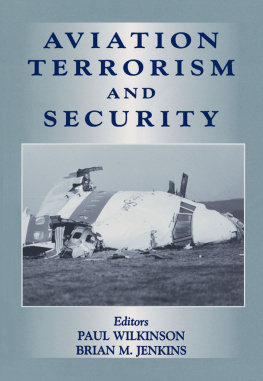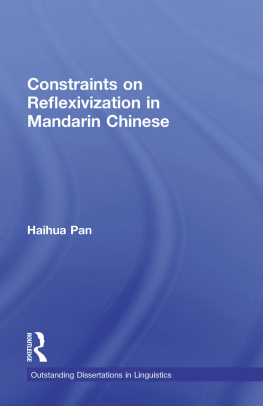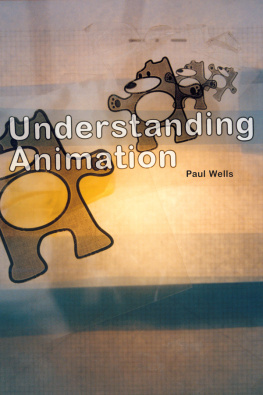First published in 1983 by
Kegan Paul International
This edition first published in 2011 by
Routledge
2 Park Square, Milton Park, Abingdon, Oxon, OX14 4RN
Simultaneously published in the USA and Canada
by Routledge
711 Third Avenue, New York, NY 10017
Routledge is an imprint of the Taylor & Francis Group, an informa business
Paul Chao 1983
All rights reserved. No part of this book may be reprinted or reproduced or utilised in any form or by any electronic, mechanical, or other means, now known or hereafter invented, including photocopying and recording, or in any information storage or retrieval system, without permission in writing from the publishers.
British Library Cataloguing in Publication Data
A catalogue record for this book is available from the British Library
ISBN 10: 0-7103-0020-4 (hbk)
ISBN 13: 978-0-7103-0020-1 (hbk)
Publishers Note
The publisher has gone to great lengths to ensure the quality of this reprint but points out that some imperfections in the original copies may be apparent. The publisher has made every effort to contact original copyright holders and would welcome correspondence from those they have been unable to trace.
Preface
Professor Paul Chao writes Chinese Kinship in the line of the Chinese tradition; it is in this tradition that cultural complexes, such as family structure and kinship in relation to religious, political and economic organizations, are expounded by analysis of concepts and supported by historical documents. For the anthropological study of kinship is indispensable as a supplement to important historical work on basis of written documents. Professor Chao has made, in the main, a study of kinship in China of all known periods. He has taken the points of view of social anthropology and has also given a history of his topic. In China, there was in one period a custom of preferred or prescribed marriage between a man and a daughter of his maternal uncle. In all known periods to this date there has been a custom of forbidden marriage between members of the same surname. Such customs as these have close analogies in some preliterate societies whose social histories were unknown. In discussing his study of such a preliterate society in the Trobriand Islands the social anthropologist Bronislaw Malinowski once said that he preferred his work to a study of a European society. But he found European societies were too complex. It is probable, however, that it was the method of fieldwork needed in the study of simple societies without recorded histories which appealed to him. In discussing Kinship in China, Professor Chao has confronted the complexity of the problem and has dealt with it adequately.
The president of Lingnam University in Canton, where I taught social anthropology at one time, married a woman of his own surname. I think that in the sequence the old custom of forbidden marriage between members of the same surname survived the revolution of 1911. I learned in China that the sentiment between a man and his mothers brothers daughter was closer than that between him and his fathers sisters daughter or between him and his remote cousins on his and their fathers side. Professor Chao reports that in certain parts of China cousin marriage is restricted to mothers brothers daughter and mothers sisters daughter. This matrilateral cross-cousin and parallel-cousin marriage is practised with the accompanying prohibition of marriage with fathers sisters daughter. But until I read Chaos work on kinship I did not know that the difference in the sentiment between cousins of opposite sex today was in part a survival of a preferred or prescribed marriage of a man to his mothers brothers daughter of a definite historical period.
Professor Chao is the author of Women Under Communism Family in Russia and China, published by General Hall in 1977. I think, therefore, that he needs no preface from me; but he is kind enough to wish me to write something of the kind. In China I took a party of students to use a method of fieldwork in the study of the Yao, a preliterate people with the blessings of the Bureau for civilizing the Yao. But I believe that, although there are a few preliterate peoples in China, there are records of them over a long period in the literature. I do not know how detailed these literary records are. I think that if Professor Chao will tell us some day, it may be of interest to know. He is a painstaking and serious student of his subject, who is well read in the Chinese literary classics, a domain in which I, for my part, have no competence.
Social anthropologists, many of whom have been Europeans, have written of a custom of forbidding marriage between couples related by common descent on one side of their families from a remote ancestor. As many of them have noticed exogamy amongst some preliterate peoples and not amongst some literate peoples, and not amongst Europeans, they have assumed that it was especially a primitive custom. Probably it was a custom with an early origin. However, there is no evidence that it was once European. As far as we can be guided by evidence, the inclination is that it was not. It appears that in European societies the rules about degrees of consanguinity were a barrier to marriage on both sides of families. There is a similar regulation in some preliterate societies. In contrast, a group of people related by common descent on one side of their families from a remote ancestor has been called a unilaterally enlarged family or a clan or a gens or a surname. In some preliterate societies it is believed that the remote ancestor from which a clan or a gens was descended was a bird, and its members were forbidden to kill or to eat that species of bird. Such a belief has been called totemic.
In this book Professor Chao says that the patrilineal category includes agnatic third cousins and rising and falling four generations in the direct line of descent. The official patterning of mourning portrays the diminishing intensity of relationships between agnates according to proximity. In ancestor worship, tablets kept in the domestic shrine are those of the deceased father, grandfather and great grandfather; tablets remain by right in the possession of primogeniture. When the family division takes place, a domestic shrine will become the ritual centre for a number of agnatically related families.
In many societies, cousins who are the children of a brother and a sister pair by their respective spouses are distinguished from cousins who are the children of brothers or the children of sisters. Social anthropologists call the former kind cross-cousin and the latter, parallel-cousin. The Chinese distinguish cousins of the same surname, called inside (tang agnatic) cousins from all other cousins, called outside (piao non-agnatic) cousins. But for more detailed study about this and other features of the reckoning of kinship in China it gives me great pleasure to recommend this book by Professor Chao to the reader. For Chinese Kinship will be counted as a landmark in the development of the anthropological theory of kinship. It is not written by an outsider looking at the kinship system in a strange land; it contains research conducted by a citizen upon his own people. If self-knowledge is the most difficult to gain, then an anthropology of ones own people is the most valuable and worthy achievement and contribution.








